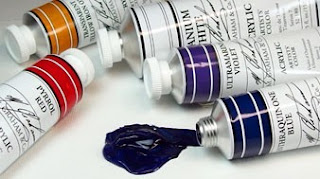Your Guide to Using Acrylic Paints
Acrylic paints are special and often complicated to use, especially for beginners. But, once you master its use, no other painting medium will be as enjoyable as acrylic paints.
The wide room available for customisation, its vibrancy, its adherence to many surfaces (both wet and dry) and the fact that no solvent is required for painting or cleanup; make acyclic paints so special among other painting mediums.
Some Of the Acrylic Paints are:
Some Of the Acrylic Paints are:
 |
M Graham Professional Acrylic Paint Tubes |
 |
M. Graham 6-Colour Acrylic Paint Primary Bonus Set 2-oz Tube |
Different types of acyclic paints
The thickness of acrylic paints is often referred to as ‘body’. The type of acrylic paint set to use for your project will depend on the technique and surface you plan on using.
Heavy body paints - these are the thickest and heaviest of the lot. There are similar to oil paints in handling and retaining brush marks and gestures.
Soft body paints - These are smoother and softer, ideal for mix media applications.
Fluid paints - As the same suggests, these are extremely fluid. Hence, they are best for minute details or staining effects.
Acrylic Gouache - These give a velvety and matte finish, The major difference between acrylic gouache and regular gouache is that the regular one is easily re-wettable and water-soluble and is essentially an opaque watercolour. While acrylic gouache cannot be re-wetted once dry.
Acrylic spray - These allow you to apply thin layers of colour onto a multitude of surfaces, If you want to apply acrylic colour on wood, these spray paints are what you need.
Different grades
Acrylic paints are graded according to their quality. The grade can help you determine the most suitable acyclic paint set as per your mastery and style.
Professional grade - This grade involves the use of the highest quality pigments and resins. For professional artists, the wide variations available in their use is easy to handle but, the same is challenging for beginners.
Artists grade - They usually involve the same pigments as the professional grade but, in more affordable proportions. The amount of fillers and binders is more than pigments.
Student grade - This grade has the lowest binder to pigment ratio. To extend the pigments, fillers and mediums are used. Hence, you can expect the paint to look chalkier with lower saturation.



Comments
Post a Comment